Effect of Annealing on Microstructure and Mechanical Properties of Al0.5CoCrFeMoxNi High-Entropy Alloys
Abstract
1. Introduction
2. Materials and Methods
3. Results and Discussion
3.1. Phase Transformation of Annealed Al0.5CoCrFeMoxNi Alloys
3.2. Microstructures of Annealed Al0.5CoCrFeMoxNi Alloys
3.3. Calculated Pseudo Binary Phase Diagram and Its Comparison with Experiments
3.4. Mechanical Properties of Annealed Al0.5CoCrFeMoxNi Alloys
4. Conclusions
- (1)
- The annealing process at 600 °C for 10 h has no obvious effect on the microstructures of the Al0.5CoCrFeMoxNi, while it can increase its hardness to some extent. The annealing at 800–1200 °C for 10 h causes the precipitation of (Al,Ni)-rich ordered BCC phase or/and (Cr,Mo)-rich σ phase, and greatly affects the microstructure and mechanical properties of the alloys.
- (2)
- The evolution of structure with temperature can be classified into four types:
- (a)
- Mo0 alloy: mixed structure (FCC + BCC/B2).
- (b)
- Mo0.1 alloy: mixed structure (FCC + BCC/B2) below 600 °C → FCC + BCC/B2+ σ (800–1000 °C) → FCC + BCC/B2 (1100–1200 °C).
- (c)
- Mo0.2–Mo0.3 alloys: mixed structure (FCC + BCC/B2 + σ) below 1100 °C → FCC + BCC/B2 (1200 °C).
- (d)
- Mo0.4–Mo0.5 alloys: mixed structure (FCC + BCC/B2 + σ).
- (3)
- The alloys annealed at 800 °C for 10 h have relatively finer microstructure and higher hardness and higher yield stress than the as-cast alloys, which can be attributed to the solid-state decomposition of FCC and B2 phases. The precipitations become larger at 1000–1100 °C.
- (4)
- The morphology and amount of each phase in the alloys vary with the Mo content and annealing temperatures. The Mo0.5 alloy annealed at 800 °C have a high compressive yield strength up to 2.1 GPa with an accepted fracture strain of 13%.
Author Contributions
Funding
Conflicts of Interest
References
- Cantor, B.; Chang, I.T.H.; Knight, P.; Vincent, A.J.B. Microstructural development in equiatomic multicomponent alloys. Mater. Sci. Eng. A 2004, 375–377, 213–218. [Google Scholar] [CrossRef]
- Yeh, J.W.; Chen, S.K.; Lin, S.J.; Gan, J.Y.; Chin, T.S.; Shun, T.T.; Tsau, C.H.; Chang, S.Y. Nanostructured high-entropy alloys with multiple principal elements: novel alloy design concepts and outcomes. Adv. Eng. Mater. 2004, 6, 299–303. [Google Scholar] [CrossRef]
- Zhang, Y.; Zuo, T.T.; Tang, Z.; Gao, M.C.; Dahmen, K.A.; Liaw, P.K.; Lu, Z.P. Microstructures and properties of high-entropy alloys. Prog. Mater. Sci. 2014, 61, 1–93. [Google Scholar] [CrossRef]
- Tsai, M.H. Three Strategies for the design of advanced high-entropy alloys. Entropy 2016, 18, 252. [Google Scholar] [CrossRef]
- Lu, Z.P.; Wang, H.; Chen, M.W.; Baker, I.; Jeh, J.W.; Liu, C.T.; Nieh, T.G. An assessment on the future development of high-entropy alloys: Summary from a recent workshop. Intermetallics 2015, 65, 67–76. [Google Scholar] [CrossRef]
- Miracle, D.B.; Senkov, O.N. A critical review of high entropy alloys and related concepts. Acta Mater. 2017, 122, 448–511. [Google Scholar] [CrossRef]
- Wang, W.R.; Wang, W.L.; Wang, S.C.; Tsai, Y.C.; Lai, C.H.; Yeh, J.W. Effects of Al addition on the microstructure and mechanical property of AlxCoCrFeNi high-entropy alloys. Intermetallics 2012, 26, 44–51. [Google Scholar] [CrossRef]
- He, J.Y.; Liu, W.H.; Wang, H.; Wu, Y.; Liu, X.J.; Nieh, T.G.; Lu, Z.P. Effects of Al addition on structural evolution and tensile properties of the FeCoNiCrMn high-entropy alloy system. Acta Mater. 2014, 62, 105–133. [Google Scholar] [CrossRef]
- Feng, R.; Gao, M.C.; Lee, C.; Mathes, M.; Zuo, T.; Chen, S.; Hawk, J.A.; Zhang, Y.; Liaw, P.K. Design of Light-Weight High-Entropy Alloys. Entropy 2016, 18, 333. [Google Scholar] [CrossRef]
- Salishchev, G.A.; Tikhonovsky, M.A.; Shaysultanov, D.G.; Stepanov, N.D.; Kuznetsov, A.V.; Kolodiy, I.V.; Tortika, A.S.; Senkov, O.N. Effect of Mn and V on structure and mechanical properties of high-entropy alloys based on CoCrFeNi system. J. Alloys Compd. 2014, 591, 11–21. [Google Scholar] [CrossRef]
- Qiu, Y.; Hu, Y.J.; Taylor, A.; Styles, M.J.; Marceau, R.K.W.; Ceguerra, A.V.; Gibson, M.G.; Liu, Z.K.; Fraser, H.L.; Birbilis, N. A lightweight single-phase AlTiVCr compositionally complex alloy. Acta Mater. 2017, 123, 115–124. [Google Scholar] [CrossRef]
- Wang, Z.; Baker, I.; Guo, W.; Poplawsky, J.D. The effect of carbon on the microstructures, mechanical properties, and deformation mechanisms of thermo-mechanically treated Fe40.4Ni11.3Mn34.8Al7.5Cr6 high entropy alloys. Acta Mater. 2017, 126, 346–360. [Google Scholar] [CrossRef]
- Zhuang, Y.X.; Liu, W.J.; Chen, Z.Y.; Xue, H.D.; He, J.C. Effect of elemental interaction on microstructure and mechanical properties of FeCoNiCuAl alloys. Mater. Sci. Eng. A 2012, 556, 395–399. [Google Scholar] [CrossRef]
- Zhou, Y.J.; Zhang, Y.; Wang, Y.L.; Chen, G.L. Solid solution alloys of AlCoCrFeNiTix with excellent room-temperature mechanical properties. Appl. Phys. Lett. 2007, 90, 181904. [Google Scholar] [CrossRef]
- Tracy, C.L.; Park, S.; Rittman, D.; Zinkle, S.J.; Bei, H.; Lang, M.; Ewing, R.C.; Mao, W.L. High pressure synthesis of a hexagonal close-packed phase of the high-entropy alloy CrMnFeCoNi. Nat. Commun. 2017, 8, 15634. [Google Scholar] [CrossRef] [PubMed]
- Ng, C.; Guo, S.; Luan, J.H.; Wang, Q.; Lu, J.; Shi, S.Q.; Liu, C.T. Phase stability and tensile properties of Co-free Al0.5CrCuFeNi2 high entropy alloys. J. Alloys Compd. 2014, 584, 530–537. [Google Scholar] [CrossRef]
- Wen, L.H.; Kou, H.C.; Li, J.S.; Chang, H.; Xue, X.Y.; Zhou, L. Effect of aging temperature on microstructure and properties of AlCoCrCuFeNi high-entropy alloy. Intermetallics 2009, 17, 266–269. [Google Scholar] [CrossRef]
- Lin, C.M.; Tsai, H.L.; Bor, H.Y. Effect of aging treatment on microstructure and properties of high-entropy Cu0.5CoCrFeNi alloy. Intermetallics 2010, 18, 1244–1250. [Google Scholar] [CrossRef]
- Jones, N.G.; Izzo, R.; Mignanelli, P.M.; Christofidou, K.A.; Tone, H.J. Phase evolution in an Al0.5CrFeCoNiCu high entropy alloys. Intermetallics 2016, 71, 43–50. [Google Scholar] [CrossRef]
- Zhuang, Y.X.; Xue, H.D.; Chen, Z.Y.; Hu, Z.Y.; He, J.C. Effect of annealing treatment on microstructures and mechanical properties of FeCoNiCuAl high entropy alloys. Mater. Sci. Eng. A 2013, 572, 30–35. [Google Scholar] [CrossRef]
- Wang, W.R.; Wang, W.L.; Yeh, J.W. Phases, microstructure and mechanical properties of AlxCoCrFeNi high entropy alloys at elevated temperatures. J. Alloys Compd. 2014, 589, 143–152. [Google Scholar] [CrossRef]
- Lu, Y.; Dong, Y.; Guo, S.; Liang, L.; Kang, H.; Wang, T.; Wen, B.; Wang, Z.; Jie, J.; Cao, Z.; et al. A promising new class of high-temperature alloys: Eutectic high-entropy alloy. Sci. Rep. 2014, 4, 6200. [Google Scholar] [CrossRef] [PubMed]
- Gao, X.; Lu, Y.; Zhang, B.; Liang, N.; Wu, G.; Sha, G.; Liu, J.; Zhao, Y. Microstructural origins of high strength and high ductility in an AlCoCrFeNi2.1 eutectic high-entropy alloy. Acta Mater. 2017, 141, 59–66. [Google Scholar] [CrossRef]
- Li, Z.; Pradeep, K.G.; Deng, Y.; Raabe, D.; Tasan, C.C. Metastable high-entropy dual-phase alloys overcome the strength-ductility trade-off. Nature 2016, 534, 227–230. [Google Scholar] [CrossRef] [PubMed]
- Li, Z.; Tasan, C.C.; Pradeep, K.G.; Raabe, D. A TRIP-assisted dual-phase high-entropy alloy: Grain size and phase fraction effects on deformation behavior. Acta Mater. 2017, 131, 323–335. [Google Scholar] [CrossRef]
- Zhuang, Y.X.; Zhang, X.L.; Gu, X.Y. Effect of molybdenum on phases, microstructure and mechanical properties of Al0.5CoCrFeMoxNi high entropy alloys. J. Alloys Compd. 2018, 743, 514–522. [Google Scholar] [CrossRef]
- Gwalani, B.; Gorsse, S.; Choudhuri, D.; Styles, M.; Zheng, Y.; Mishra, R.S.; Banerjee, R. Modifying transformation pathways in high entropy alloys or complex concentrated alloys via thermo-mechanical processing. Acta Mater. 2018, 153, 169–185. [Google Scholar] [CrossRef]
- Lin, C.M.; Tsai, H.L. Evolution of microstructure, hardness, and corrosion properties of high-entropy Al0.5CoCrFeNi alloy. Intermetallics 2011, 19, 288–294. [Google Scholar] [CrossRef]
- Rao, J.C.; Diao, H.Y.; Ocelik, V.; Vainchtein, D.; Zhang, C.; Kuo, C.; Tang, Z.; Guo, W.; Poplawsky, J.D.; Zhou, Y.; et al. Secondary phases in AlxCoCrFeNi high-entropy alloys: An in-situ TEM heating study and thermodynamic appraisal. Acta Mater. 2017, 131, 206–220. [Google Scholar] [CrossRef]
- Choudhuri, D.; Gwalani, B.; Gorsse, S.; Mikler, C.V.; Ramanujan, R.V.; Gibson, M.A.; Banerjee, R. Change in the primary solidification phase from fcc to bcc-based B2 in high entropy or complex concentrated alloys. Scr. Mater. 2017, 127, 186–190. [Google Scholar] [CrossRef]
- Tsai, M.H.; Chang, K.C.; Li, J.H.; Tsai, R.C.; Cheng, A.H. A second criterion for sigma phase formation in high entropy alloys. Mater. Res. Lett. 2016, 4, 90–95. [Google Scholar] [CrossRef]
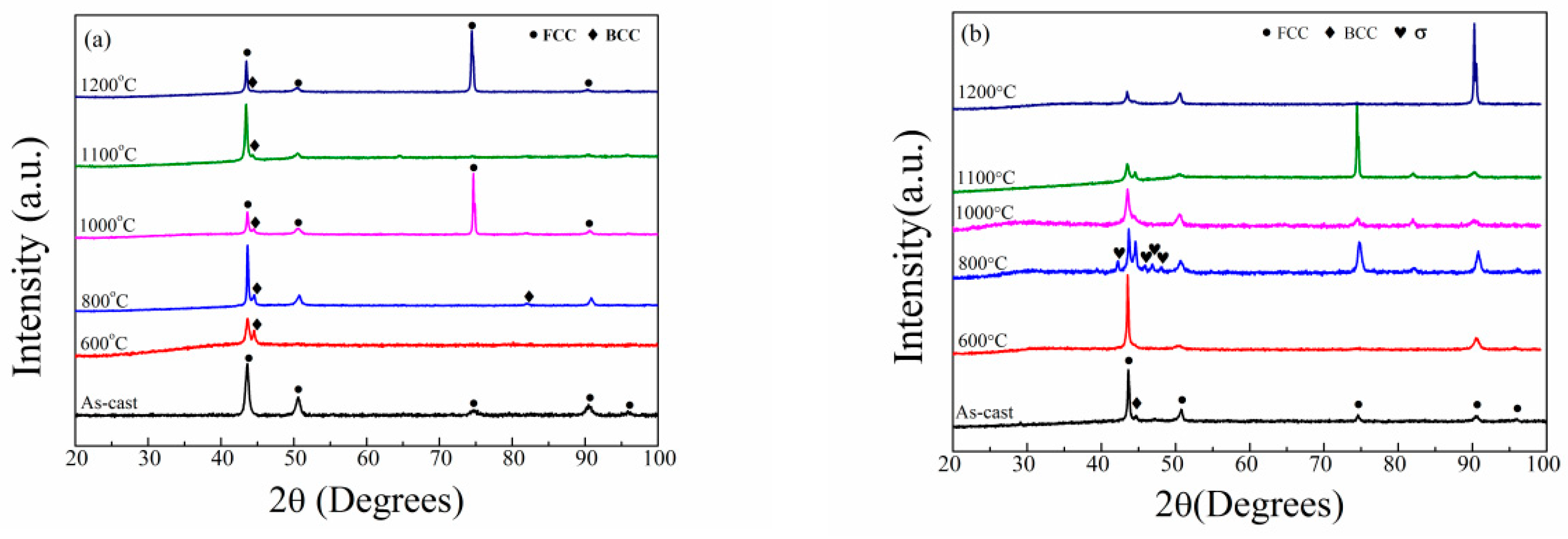
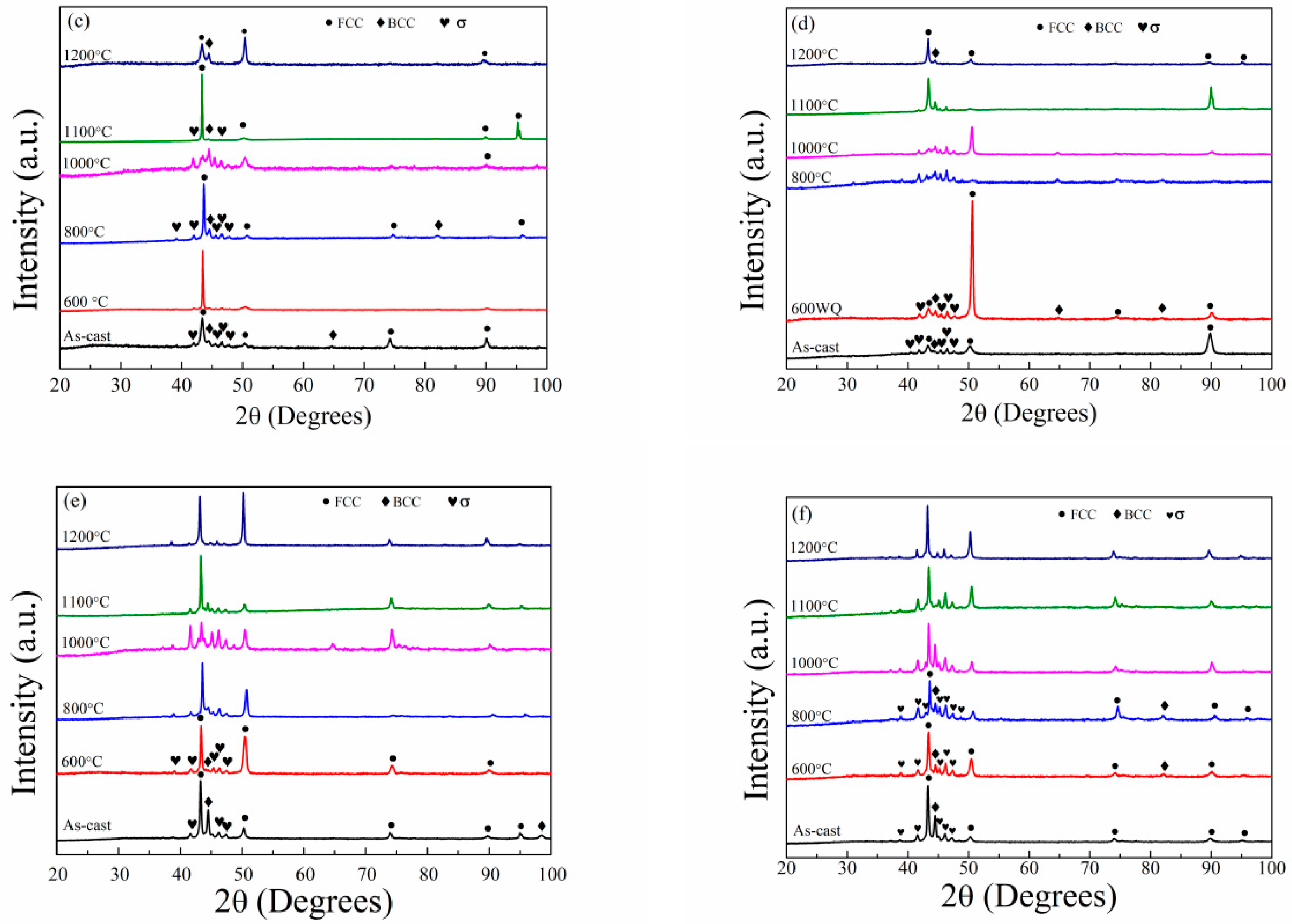
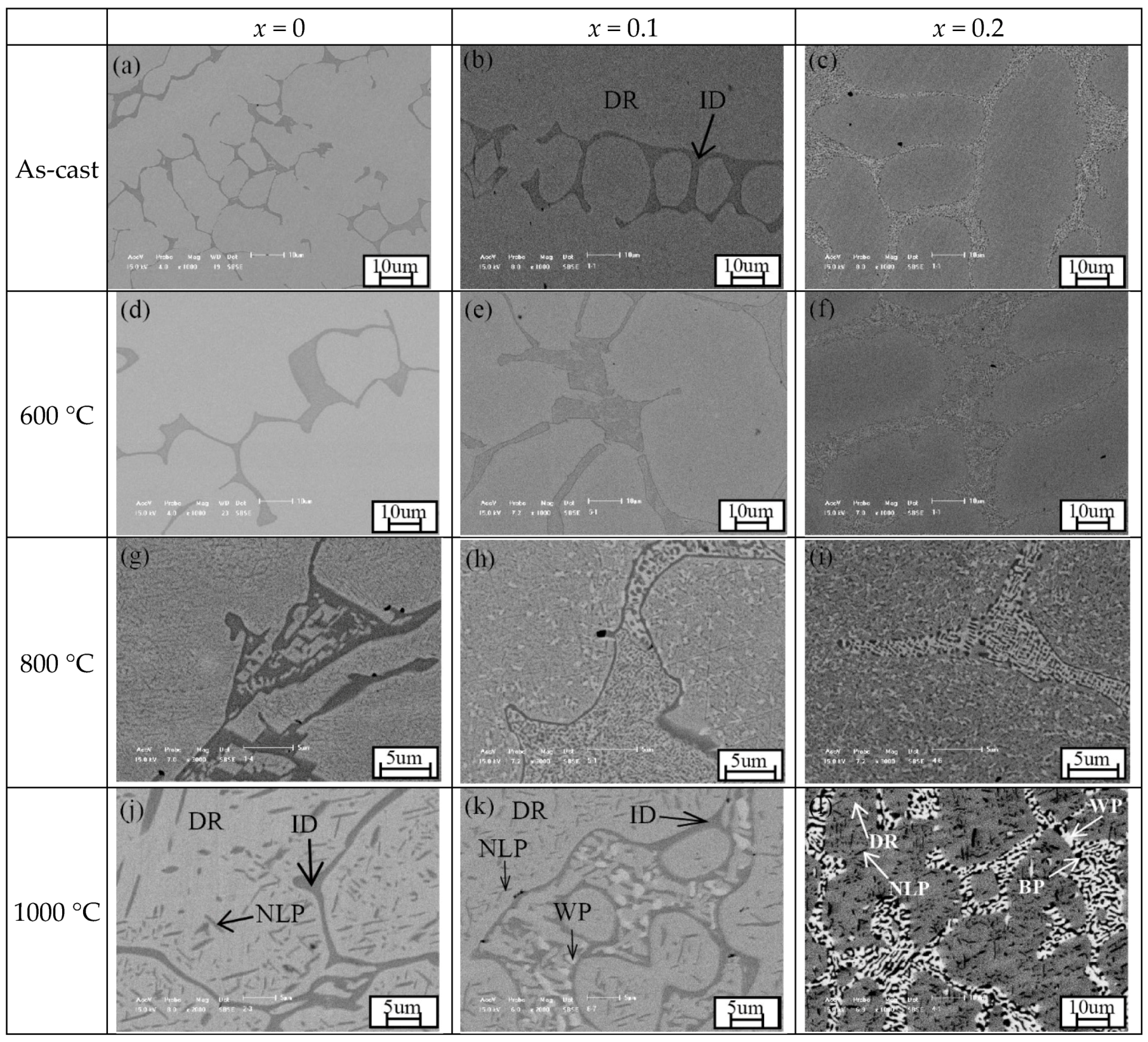

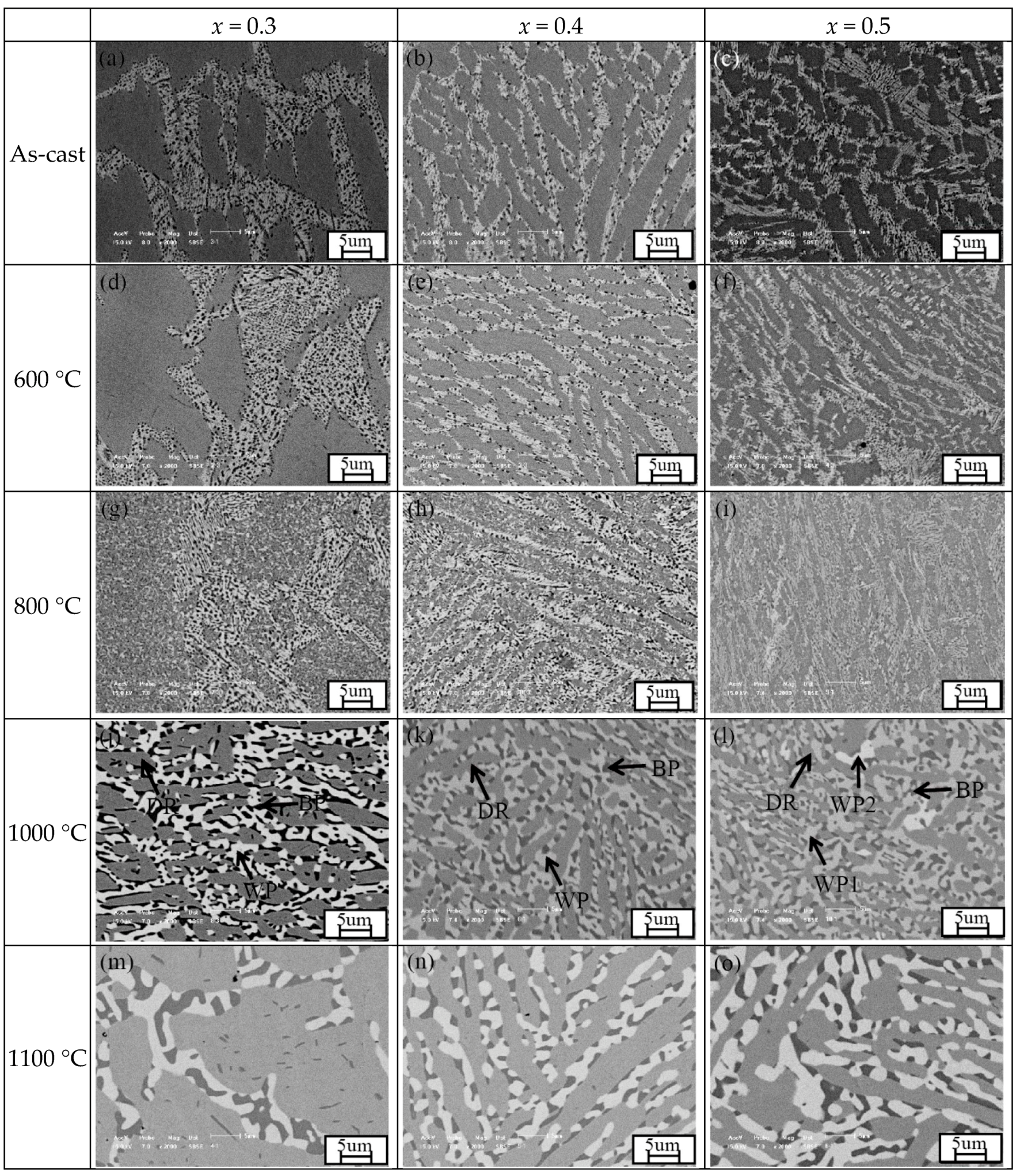

 have the same phase constituents as calculated results.
have the same phase constituents as calculated results.
 have the same phase constituents as calculated results.
have the same phase constituents as calculated results.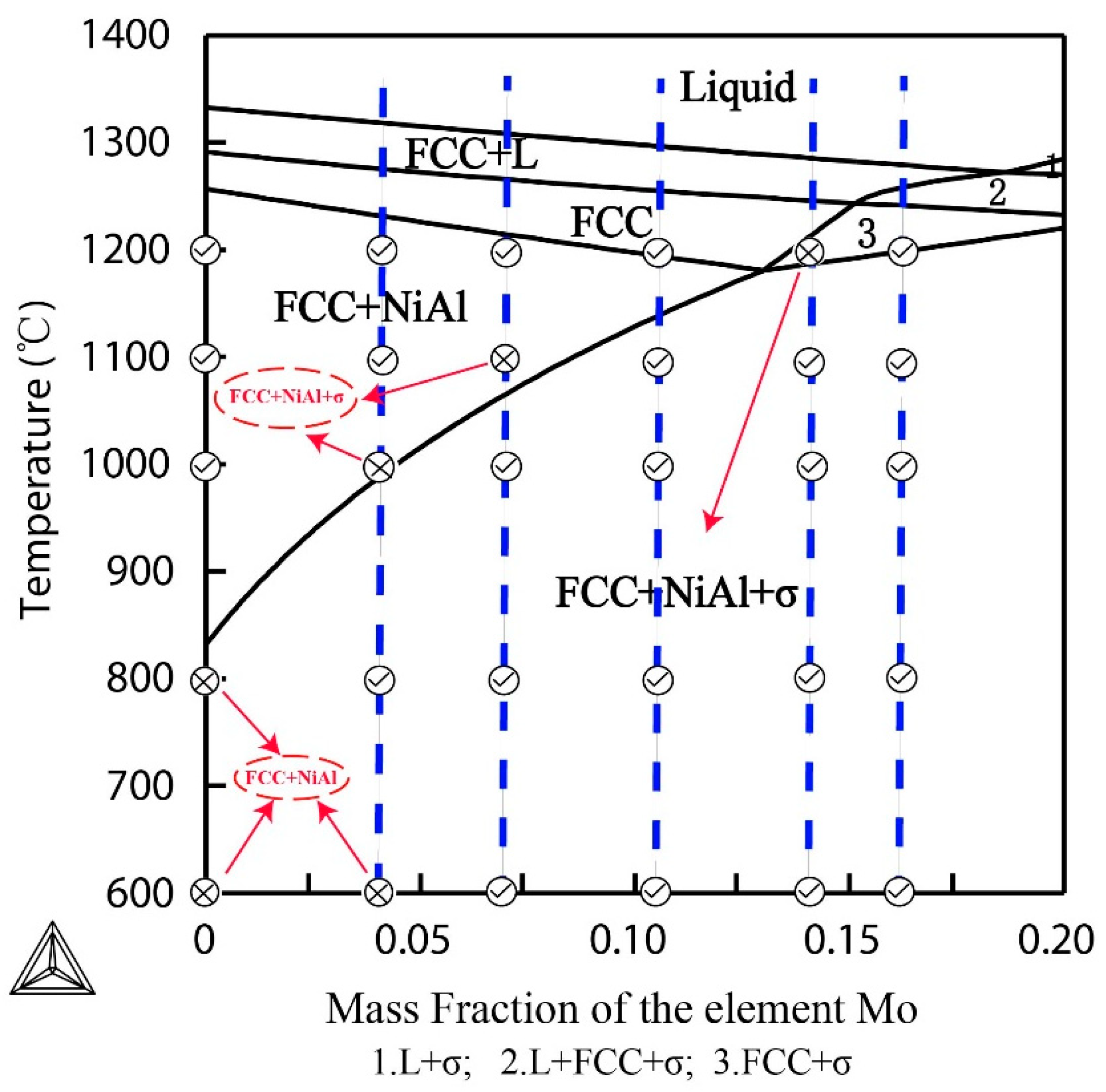
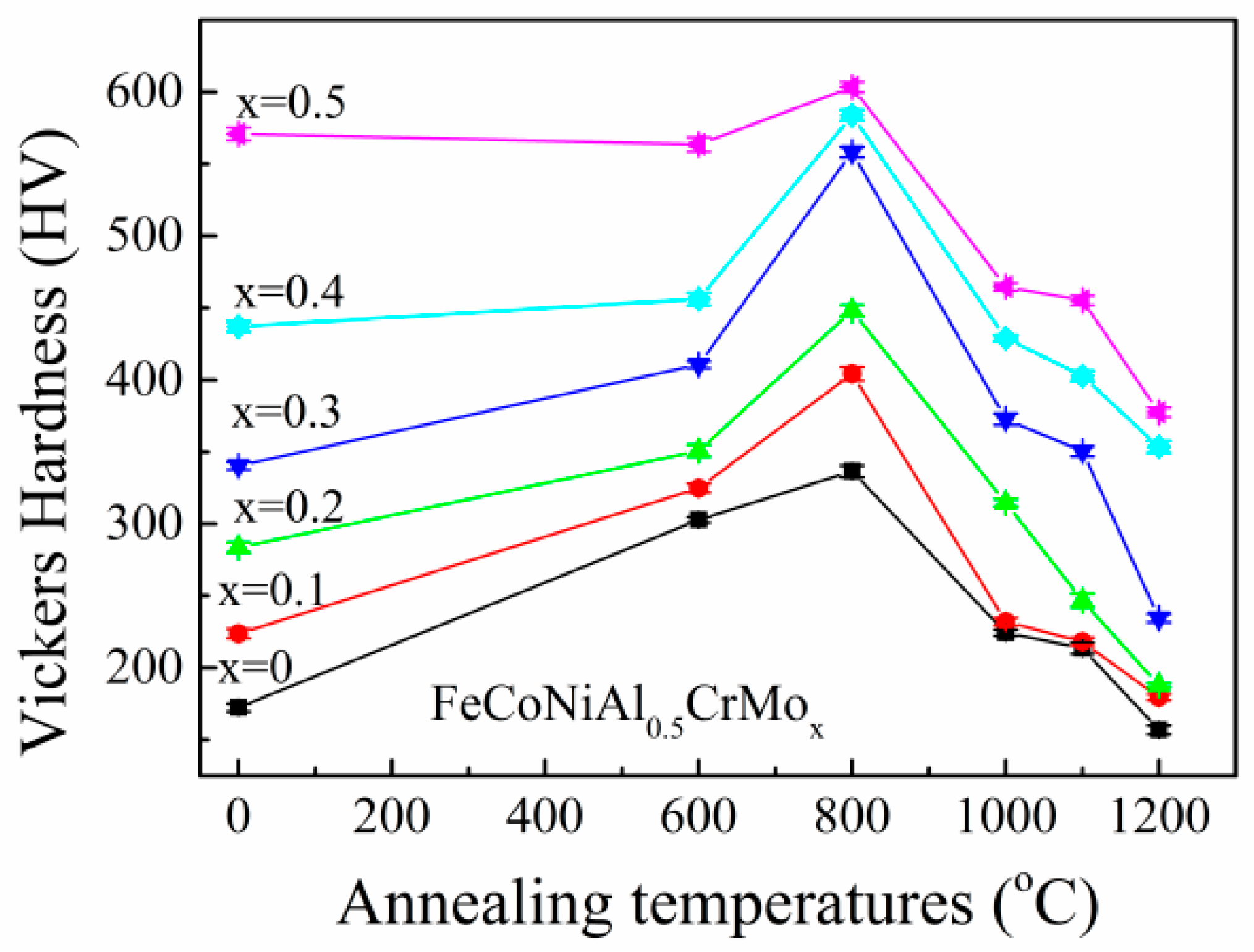
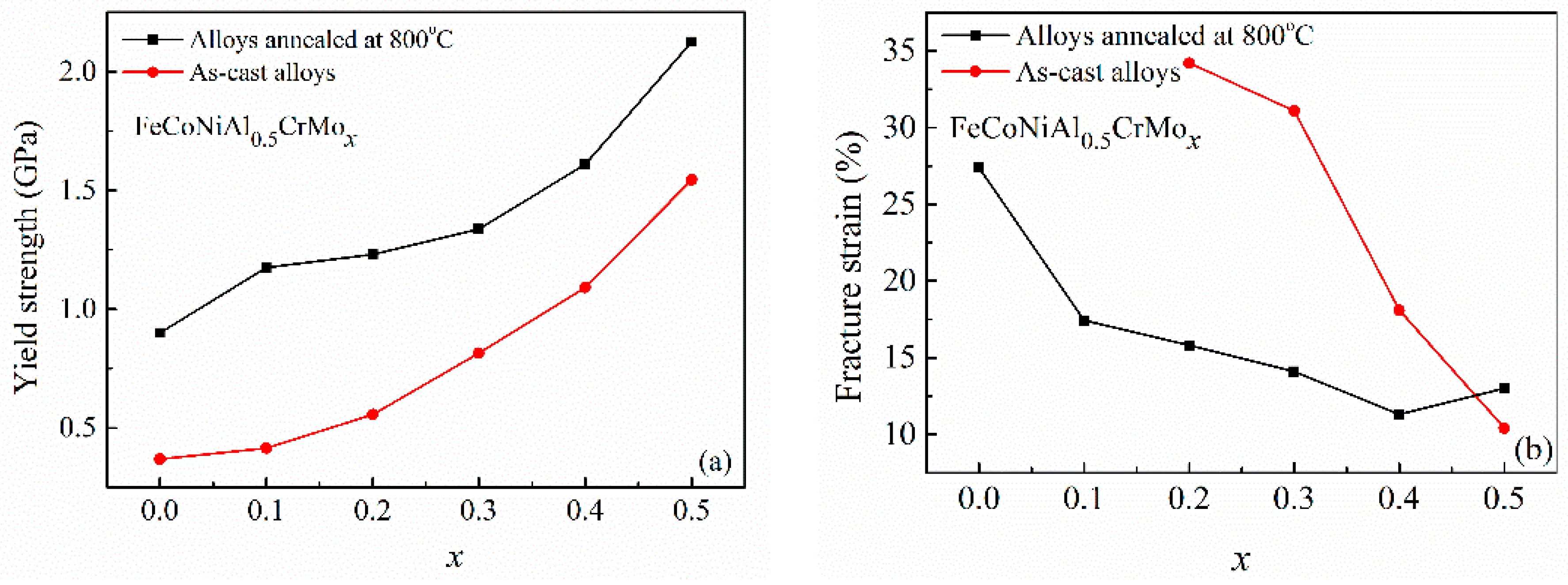
| Alloys | Phases | Fe | Co | Ni | Al | Cr | Mo |
|---|---|---|---|---|---|---|---|
| Mo0-1000 | DR: FCC | 22.3 | 23.8 | 21.5 | 7.2 | 25.2 | - |
| ID: (Al,Ni)-rich BCC | 11.0 | 15.5 | 35.5 | 30.6 | 7.4 | - | |
| NLP: (Al,Ni)-rich BCC | 16.0 | 18.6 | 22.4 | 31.2 | 11.8 | - | |
| Mo0.1-1000 | DR: FCC | 24.3 | 23.5 | 16.4 | 7.6 | 25.5 | 2.7 |
| ID: (Al,Ni)-rich BCC | 14.8 | 19.8 | 22.6 | 30.9 | 10.8 | 1.1 | |
| NLP: (Al,Ni)-rich BCC | 16.8 | 16.8 | 28.5 | 20.7 | 15.7 | 1.6 | |
| WP: (Cr,Mo)-rich σ | 19.3 | 18.5 | 6.7 | 4.4 | 40.5 | 10.6 | |
| Mo0.2-1000 | DR: FCC | 23.7 | 21.0 | 20.6 | 8.2 | 21.2 | 5.3 |
| BP: (Al,Ni)-rich BCC | 13.7 | 15.2 | 28.2 | 20.6 | 15.9 | 6.4 | |
| WP: (Cr,Mo)-rich σ | 20.9 | 20.5 | 14.9 | 6.0 | 28.1 | 9.6 | |
| NLP: (Al,Ni)-rich BCC | 20.2 | 22.9 | 21.9 | 11.0 | 19.6 | 4.5 |
| Alloys | Regions | Fe | Co | Ni | Al | Cr | Mo |
|---|---|---|---|---|---|---|---|
| Mo0.3-1000 | DR: FCC | 22.8 | 18.8 | 21.3 | 10.1 | 20.7 | 6.3 |
| BP: (Al,Ni)-rich BCC | 10.7 | 15.7 | 33.1 | 30.2 | 7.6 | 2.8 | |
| WP: (Cr,Mo)-rich σ | 18.1 | 18.6 | 7.7 | 3.6 | 30.3 | 21.6 | |
| Mo0.4-1000 | DR: FCC | 25.7 | 20.7 | 18.8 | 7.6 | 21.2 | 6.0 |
| BP: (Al,Ni)-rich BCC | 9.3 | 17.5 | 30.6 | 25.0 | 11.5 | 6.1 | |
| WP: (Cr,Mo)-rich σ | 19.0 | 18.7 | 9.8 | 3.0 | 25.1 | 24.4 | |
| Mo0.5-1000 | DR: FCC | 23.3 | 21.3 | 21.1 | 7.0 | 17.7 | 9.5 |
| BP: (Al,Ni)-rich BCC | 12.4 | 10.5 | 35.5 | 29.4 | 6.3 | 6.0 | |
| WP1: (Cr,Mo)-rich σ | 16.4 | 17.2 | 9.9 | 2.8 | 25.0 | 28.7 | |
| WP2: (Cr,Mo)-rich | 14.0 | 15.9 | 8.4 | 2.0 | 17.3 | 42.3 |
© 2018 by the authors. Licensee MDPI, Basel, Switzerland. This article is an open access article distributed under the terms and conditions of the Creative Commons Attribution (CC BY) license (http://creativecommons.org/licenses/by/4.0/).
Share and Cite
Zhuang, Y.-X.; Zhang, X.-L.; Gu, X.-Y. Effect of Annealing on Microstructure and Mechanical Properties of Al0.5CoCrFeMoxNi High-Entropy Alloys. Entropy 2018, 20, 812. https://doi.org/10.3390/e20110812
Zhuang Y-X, Zhang X-L, Gu X-Y. Effect of Annealing on Microstructure and Mechanical Properties of Al0.5CoCrFeMoxNi High-Entropy Alloys. Entropy. 2018; 20(11):812. https://doi.org/10.3390/e20110812
Chicago/Turabian StyleZhuang, Yan-Xin, Xiu-Lan Zhang, and Xian-Yu Gu. 2018. "Effect of Annealing on Microstructure and Mechanical Properties of Al0.5CoCrFeMoxNi High-Entropy Alloys" Entropy 20, no. 11: 812. https://doi.org/10.3390/e20110812
APA StyleZhuang, Y.-X., Zhang, X.-L., & Gu, X.-Y. (2018). Effect of Annealing on Microstructure and Mechanical Properties of Al0.5CoCrFeMoxNi High-Entropy Alloys. Entropy, 20(11), 812. https://doi.org/10.3390/e20110812




